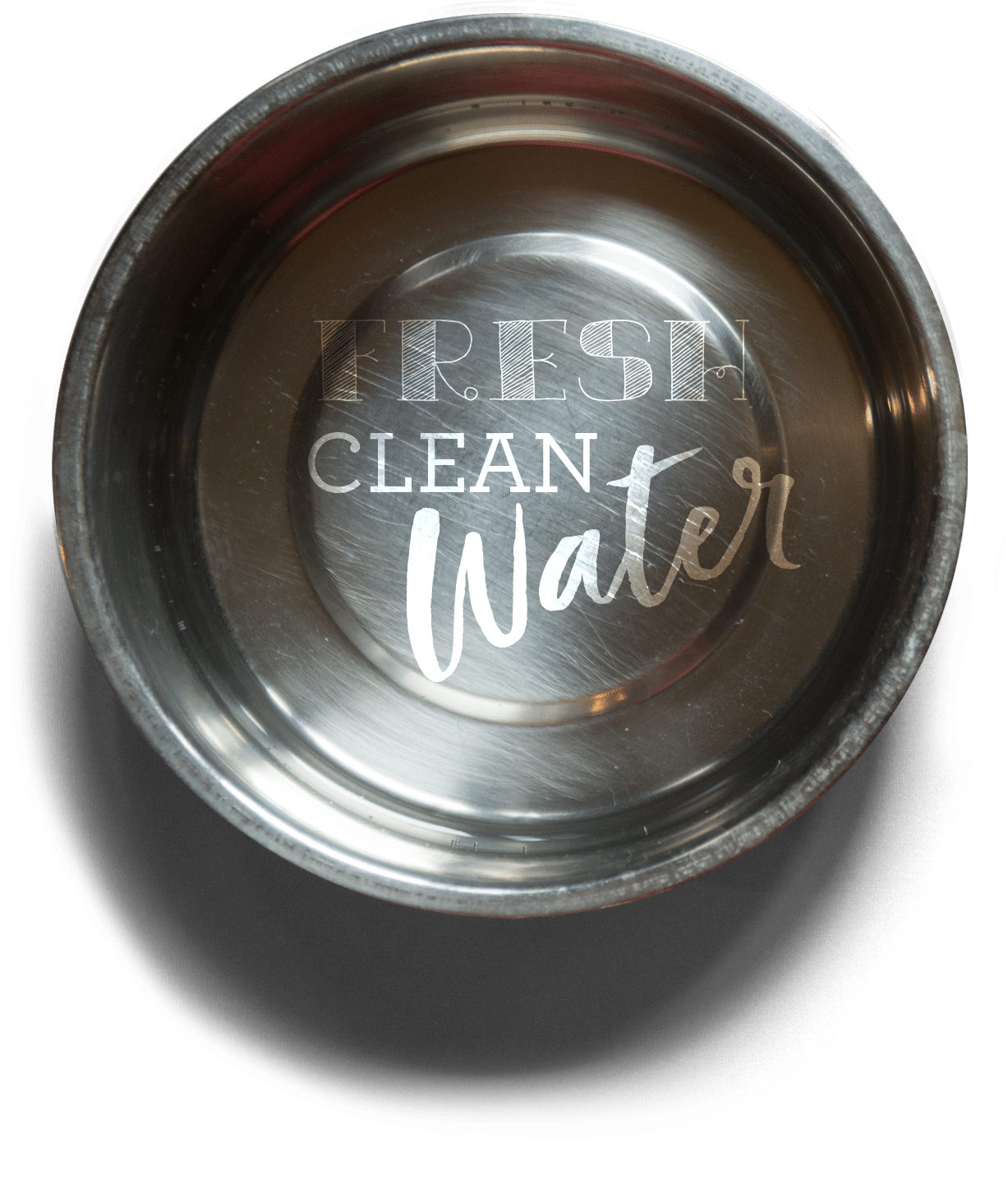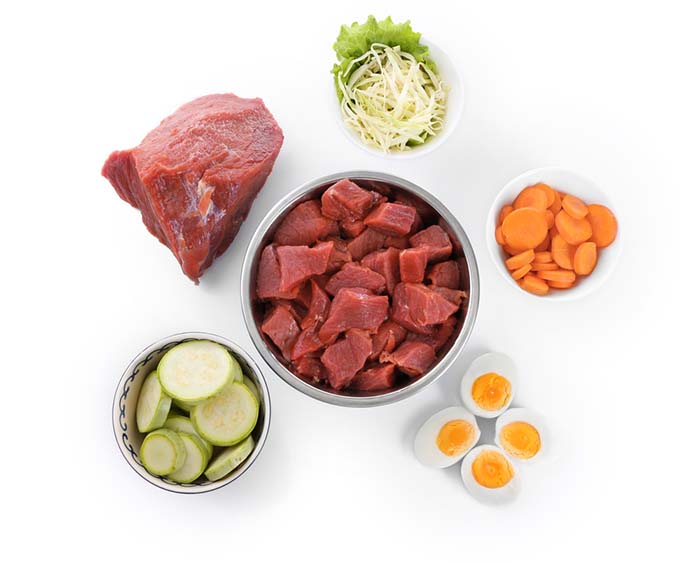
As Global Animal explains, drinking water provides many health benefits for our pets, including hydration, lubricating joints to make it easier for pets to move around, aiding the digestive system to breakdown food and absorb nutrients, regulating body temperature and eliminating waste and toxins from the body.
Water is especially important for older pets as their kidneys may not be able to conserve water as well as they did when they were younger, increasing the risk of dehydration. For good overall health, water is a must!
In the Texas heat, water is especially important for helping our pets stay cool and maintain normal body temperature. One of the main ways our pets cool down is panting and sweating through their paw pads. As water leaves our pet’s tongue, heat is carried away from the body allowing them to cool down. It is important they rehydrate so they stay healthy. Having plenty of fresh, clean water on hand at all times ensures they can do this as needed.
Puddles of water often have contaminants that can be harmful to pets. Chemicals from lawns or cars can be found in many puddles and could harm pets. Leptospirosis bacteria and giardia organisms can also be found in some puddles and could cause a variety of health issues for pets.
The same germs that make people sick, can also make pets sick. Even filtered water or ice from the refrigerator can still contain germs that may make your pet sick. Instead, use bottled water or boil tap water at a rolling boil for at least two minutes to kill germs. Be sure the water is completely cooled before giving it to your pets.
Trying to decide what food to give pets can be confusing – there are so many choices! The ASPCA offers nutrition tips for cats and dogs to make selection easier for owners.
There are quality pet foods available for sale at a variety of prices at grocery and pet stores. Many online stores even make pet food available for home delivery at no additional cost, which is great when you are short on time or don’t want to break your back lugging a huge bag of food!
Fortunately, Greater Houston pet owners facing financial challenges may be able to get help through pet pantries or other resources if they are having difficulty affording pet food.
Yes! There are many foods that are toxic to our pets. Some of the most dangerous foods for dogs include xylitol or birch sugar (found in many gums, candies and baked goods), chocolate, grapes and raisins, garlic, and onions to name a few. These foods are also dangerous foods for cats, along with a variety of plants and household products discussed in the Safety Needs section.
Eating these foods could cause mild reactions, such as vomiting or an upset stomach or could lead to more serious consequences such as kidney failure or even death. As a pet parent, you should become familiar with the list of dangerous foods and post it in your kitchen to make sure you and your houseguests keep your pets safe.
Symptoms of food allergies include skin problems, licking of feet, diarrhea, chronic gas and ear inflammation. If you suspect a food allergy, work with your veterinarian to identify the cause and eliminate that food from your pet’s diet.
Your veterinarian may suggest removing certain ingredients from your pet’s food or trying a special diet.
Puppy and kitten food is specially formulated to provide their growing bodies with the extra calories and nutrients needed during this early stage of life. Depending on the breed and size of your pet, your veterinarian may recommend transitioning to adult food between the ages of 9 and 18 months.
The ingredients list of a pet food product can often tell very little about the nutritional value of the food. Even ingredients commonly considered bad, like meat meal and corn, have their merits. Furthermore, often, pet food companies will market their products with unregulated terms like “human-grade,” “holistic,” and even “organic.” Rather than relying on strictly on labels, vets recommend to:
It’s best to mix new food in with old food little by little. Use the ratio method, incorporating:
~25% new food into your pet’s diet for the first three days
~50% for the next three days
~75% for the next three days until you make a complete switch.
Ensure that you’re paying attention to the new food’s serving size, or you might over- or under-feed your pet, and keep an eye out for adverse reactions or food sensitivities.


When pets spend time outside, it is helpful for them to have a safe, comfortable place to go to get out of direct sunlight or rain and to keep warm or cool, depending on the season. If outdoor temperatures are too uncomfortable for you, they are probably too uncomfortable for your pet.
Many cities have ordinances that require owners to provide shelter, although some have not defined it clearly. In general, it is helpful for the space to have a roof and at least three sides so the pet can safely and comfortably relax when not with you inside your home.
If you have options on where to place the shelter, you could consider placing the house parallel to the wind (usually blowing east to west), in a spot with some shade, and on higher ground to make sure the area doesn’t flood or get too muddy.

Although some people believe that our pet’s hair protects them from the elements, dogs and cats can also become very uncomfortable if left unprotected in the weather. In extreme cases, they can be at risk for illness or even death.
Texas Law (Sec. 821.077) prohibits owners from leaving dogs outside when the actual or “feels like” temperature is below 32 degrees, when a heat advisory has been issued by local or state authorities or when the National Weather Service has issued a warning for a hurricane, tropical storm or tornado. Owners who do not abide by these laws may have their animals seized and face fines or cruelty charges.
Just remember, if it’s too uncomfortable for you, it’s too uncomfortable for your pets.
Our pets can absolutely get heatstroke in these hot Texas temperatures. When it gets hot, pets can have a hard time regulating their body temperature. Learn to recognize the signs of heatstroke in dogs and cats and call your veterinarian if they start to show these symptoms.
Dogs that are young, overweight, elderly or dark colored are especially at risk for heat stroke. Breeds with flat faces, like Pugs, Bulldogs and Persian cats, are also at higher risk as they cannot pant as effectively.
The best way to keep pets cool is to keep them indoors when it’s hot. If they are outside, making sure pets have fresh water and shade is the most important way to keep pets cool. Pets’ paws are built to help keep them cool. Staying off hot pavement, which can cause burns to their feet, will help them. You can also hose down the concrete or provide a shallow baby pool or container of water for them to splash around in. Don’t encourage vigorous exercise in prime heat, and be sure not to tightly muzzle dogs restricting their ability to pant.
Although people may assume that a pet’s hair will protect them from the sun, cats and dogs can get sunburned and can even get skin cancer! Just as UV rays can penetrate our hair to burn our scalp, this can happen to our pet’s skin. Hartz says pets that are white, light colored, short haired or hairless are at highest risk for burns.
Providing your pets with shelter is one excellent way to protect them from burns. Pet sunscreen is also available to help avoid a painful burn.
Although temperatures do not get as low here as in many parts of the country, it does get cold enough that your pet could die if left outside. Pets that are young, old or have health issues are especially at risk for developing hypothermia. Also, smaller pets generally have a harder time staying warm than bigger pets.
When temperatures drop or your pet is shivering from the cold, allowing them to come inside your home is the kindest step you can take. Limit their time outdoors and make sure they have an insulated shelter that protects them from the wind and cold. If you are going out for a walk, you may try having him or her wear a sweater or covering.
While a little rain won’t usually hurt a pet, it is not a good idea to leave them out for very long as there are several safety concerns that could impact your pet.
Greater Houston is known for sudden street flooding, which can present dangers to pets. Not only is the rising water a concern, but the water may contain contaminants, insects and animals that could harm your pet. If there is lightning and thunder, your pet may also become afraid, which could cause them to try to escape your yard. If they do get out, the rain could cause motorists to have a hard time seeing your pet, putting your pet and the driver at greater risk.